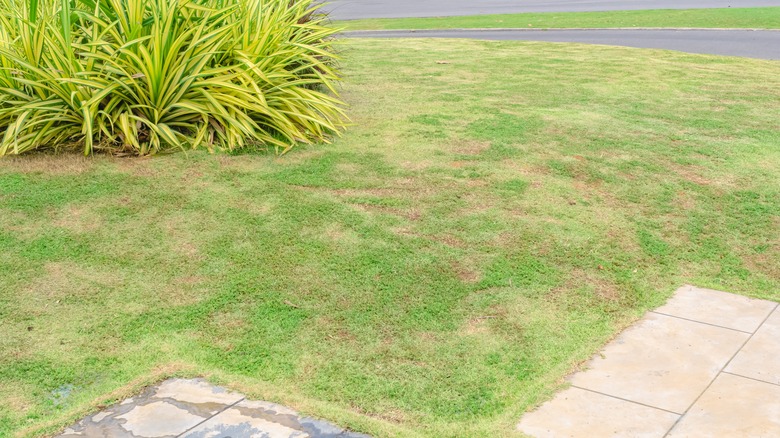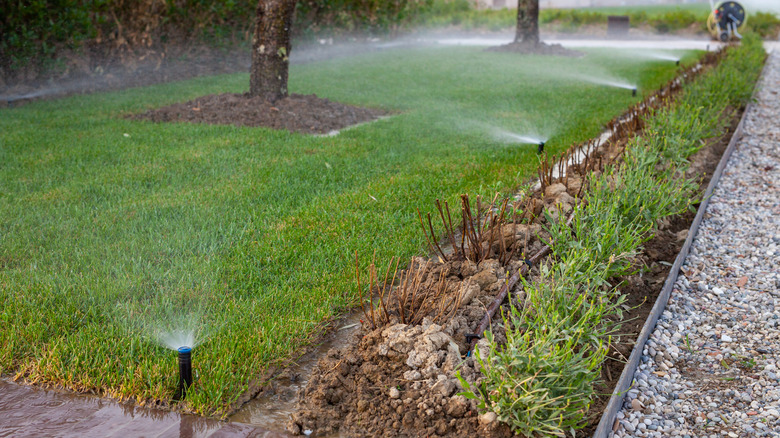This Is When Your Lawn Is Most Susceptible To Fungus
If you're experiencing turf trouble, you're probably on the hunt for tips to keep your sunny lawn healthy and green. One of the many (many!) fungal diseases that infiltrate backyards across the country is a likely cause of lawn damage, and an oft-shared cure proffered by lawn care experts is to familiarize yourself with the conditions that cause said infections. Most fungal diseases appear in spring, summer, and fall — with one exception, snow mold, which thrives under winter snow cover. The environmental thread that connects these diseases is excessive moisture. That could be particularly humid conditions, a period of rain (especially after an extended drought), or irrigation practices poorly suited to the species of grass you're growing in your backyard.
Dedicated lawn caretakers know that early spring and late fall are a tricky time for grasses because, depending on which cultivar or species you're growing, the plants are either going into or coming out of dormancy. In some places, warm, wet winters make for lawn fungus disease-filled springs, as does cool, wet fall weather after a particularly hot summer. Any period of change stresses your grass, making it more vulnerable to infection. Spring is also a time when the winds pick up and the rains start, spreading fungal spores around your yard like sprinkles on a green velvet cake. Other catalysts for turfgrass fungus outbreaks include cutting your lawn overly short, drought, excessive shade (including lots of cloudy days), too much or too little fertilization, a boggy backyard, and overuse of chemical controls like herbicides and pesticides. New lawns under one year old also have less immunity to disease than established lawns.
Warm season fungal diseases and what to do about them
Summer fungus brown patch lawn disease loves warm (68 to 86 degrees Fahrenheit), humid, rainy environments, and grows on Bermuda grass and tall fescue to ryegrass, bluegrass, and bentgrass. Watch out for take-all disease from June through October, though it may also appear in early spring if conditions — heat, drought, shade, and too much salt — are right. Other summer fungi of note include turf grass rust, which thrives in heavy dew; high soil pH and heat-loving summer patch; gray leaf spot, which targets cool season species of annual and perennial ryegrass, tall fescue, and St. Augustine grass; and the mostly aesthetically unpleasing red thread, triggered by perpetually damp grass blades and dry roots.
Dollar spot is probably the most common spring and fall turf grass fungal disease, appearing when mornings get dewy and humidity rises. It's worse when the soil (not the grass itself) is dry and lacking in nitrogen. Lawns of popular Kentucky bluegrass are susceptible to Ascochyta leaf blight in these seasons, though exactly what starts it growing is not well understood.
Not choosing the correct turf grass cultivar for your specific climatic conditions is among the more surprising ways you've been killing your grass without knowing it — or at the very least making it more susceptible to fungal infection. Once the grass is growing, the key to preventing fungal disease overgrowth is irrigating your lawn in the morning so the blades dry quickly in the sun. Never leave grass wet overnight. Keep on top of lawn maintenance tasks, like regular fertilization, mowing, and inspection, too. Healthy grass is less likely to succumb to disease.

